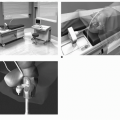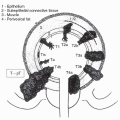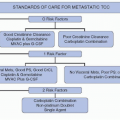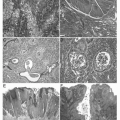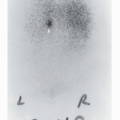Diagnosis and Management of Pheochromocytoma
Jay S. Fonte
Jan Breza
W. Marston Linehan
Gennady Bratslavsky
Karel Pacak
Pheochromocytoma is a tumor arising from the chromaffin cells of the adrenal medulla that is able to synthesize, store, metabolize, and produce catecholamines (1). It is also referred to as intra-adrenal paraganglioma (PGL) by the World Health Organization, while closely related tumors of the extra-adrenal sympathetic and parasympathetic ganglia are classified as extraadrenal PGL (2). Tumors of the parasympathetic paraganglia found in the head and neck, formerly referred to as glomus tumors, rarely produce significant amounts of catecholamines, whereas tumors of the adrenal medulla and the sympathetic nervous system behave similarly in their ability to produce catecholamines (1). Thus, pheochromocytoma is still preferably used by many, as it is in this chapter, to refer to tumors of both the adrenal medulla and extra-adrenal sympathetic ganglia.
Pheochromocytoma is an uncommon disease but constitutes a curable cause of secondary hypertension that will only prove to be fatal if unrecognized and not treated.
GENETIC SYNDROMES
Up to one third of pheochromocytomas were recently found to be due to germ line mutations in any of the six susceptibility genes identified to date (3,4,5). Hereditary pheochromocytomas can present as (a) a component of hereditary syndromes such as multiple endocrine neoplasia 2 (MEN 2), von Hippel-Lindau (VHL), and neurofibromatosis type 1 (NF 1), and the recently recognized PGL syndromes, or (b) an apparently sporadic tumor where personal and family history of related tumors are entirely lacking despite an underlying gene mutation. All of these are inherited in an autosomal dominant pattern.
MEN 2 is associated with activating germline mutation in the RET protooncogene found in chromosome 10q11.2 (6). RET gene mutation predisposes to two distinct syndromes: MEN 2A (medullary thyroid cancer [MTC], primary hyperparathyroidism, and pheochromocytoma) and MEN 2B (MTC, pheochromocytoma, mucosal neuroma, and marfanoid habitus) (1). Pheochromocytomas in MEN 2 are predominantly adrenal in location with high tendency of bilateral involvement (3,4,5,6,7). The biochemical phenotype is consistent with hypersecretion of epinephrine (EPI), which explains why patients predominantly manifest with hypertension (8,9,10). The majority of pheochromocytomas in MEN 2 are benign (4,5,6,7).
VHL is caused by germline mutation in the VHL gene located in chromosome 3p25-26 (1,6). VHL has three distinct clinical types based on the absence (Type 1) or presence (Type 2) of pheochromocytoma together with other findings such as retinal angioma, hemangioblastoma, renal cyst or renal cell carcinoma, and pancreatic islet cell tumor, with the very rare Type 2c developing pheochromocytoma alone (1). Pheochromocytomas in VHL mostly affect the adrenals and are rarely malignant (3,4,5,6,10). Compared with MEN 2, the frequency of synchronous bilateral adrenal involvement is higher (3,4,5,6) and tumors secrete predominantly norepinephrine (NE) (8). Both MEN 2 and VHL have also been linked to the development of head and neck PGL in a few cases (10).
NF 1 is caused by mutation in NF 1 gene located in chromosome 17q11.2 that lends predisposition to develop café au lait spots, multiple skin and mucosal fibromas, and Lisch nodules (6). Pheochromocytoma is a minor component of NF 1 that occurs in about 1% of cases (6,11). It mostly affects the adrenals, secretes predominantly NE, and is rarely malignant (3,4,5,6,11).
Hereditary PGL is due to mutation in the genes encoding the succinate dehydrogenase (SDH) complex. PGL 1 is due to SDHD gene mutation found in chromosome 11q23 (7). It is responsible for majority of head and neck PGL but can manifest as extra-adrenal and intra-adrenal pheochromocytomas as well with low malignant potential (3,4,5,6,12,13,14). PGL 3 is caused by SDHC gene mutation found in chromosome 1q21, which has been linked to the development of head and neck PGL with only very few cases reported in extra-adrenal sites (3,6,12). PGL 4 is caused by SDHB gene mutation found in chromosome 1p36, which predisposes to the development of head and neck PGL, and intra-adrenal and extra-adrenal pheochromocytomas (3,4,5,6,12,13,14,15). SDHB-related pheochromocytomas are often large; thus, majority of patients present due to tumor mass effect (4,9,15). It was further shown that the biochemical phenotype is consistent with hypersecretion of NE and dopamine (DA) by the tumor (15). The most outstanding feature of SDHB-related pheochromocytoma, however, is the high malignant potential among pheochromocytomas and associated poor prognosis compared with non-SDHB-related malignancies (16). Compared with the classic pheochromocytoma syndromes, family history is lacking in majority of cases of hereditary PGL. In the International Consortium Study, family history was negative in 52% of SDHD, 75% of SDHB, and 88% of SDHC-related tumors (17).
The presence of gene mutation is characterized by a young age at presentation, presence of multiple tumors, tumors in extra-adrenal locations, a positive family history, head and neck PGL, recurrent disease, and malignant tumor (3,4,5,12,13,14,15). The mean age at diagnosis was different from each cohort but was generally <40 years in all syndromes except in NF 1 where most patients were diagnosed between 40.1 through 42.3 years (3,4) and SDHC-related PGL where the mean age at presentation was 43 years (3). Genetic testing is vital for downstream management of the index patient and allows early diagnosis and treatment of family members. Because screening for all of the six genes is cumbersome and expensive, it is recommend that gene testing should be limited to patients with at least one of the features enumerated above (3,4,5,12,13,14). Nevertheless, all patients should be followed up regularly, and the occurrence of any of these features at some time during the follow-up period merits gene testing.
Once gene testing is considered, the first task of the clinician is to identify whether the tumor is part of the classic pheochromocytoma syndromes (4). The occurrence of pheochromocytoma on a history of MTC (with or without hyperparathyroidism) or hemangioblastomas should increase suspicion for MEN 2 and VHL, respectively. However, pheochromocytoma in MEN 2 and VHL can present as apparently
sporadic tumor as well in up to 18.2% (5) and 22% (9) of cases, respectively. In contrast, all pheochromocytomas in NF 1 described so far occurred with positive family history or were accompanied by other findings such as café au lait spots and skin or mucosal fibromas (4,11). Thus, in select apparently sporadic cases, VHL and RET gene testing may still be considered, while routine testing for NF 1 gene mutation in the absence of family history and consistent clinical findings is not currently recommended (5).
sporadic tumor as well in up to 18.2% (5) and 22% (9) of cases, respectively. In contrast, all pheochromocytomas in NF 1 described so far occurred with positive family history or were accompanied by other findings such as café au lait spots and skin or mucosal fibromas (4,11). Thus, in select apparently sporadic cases, VHL and RET gene testing may still be considered, while routine testing for NF 1 gene mutation in the absence of family history and consistent clinical findings is not currently recommended (5).
Underlying genetic disorder in apparently sporadic cases have been shown to present in a clinical profile distinct to the specific gene mutation. From this body of knowledge, recommendations were made as to which gene should be tested first based on location, age, number, and malignant potential of tumors. As summarized in Table 51.1, in the absence of head and neck involvement, intra-adrenal pheochromocytomas should be tested for VHL gene mutation first, especially with bilateral involvement, followed by RET, then SDHB and lastly, SDHD; extra-adrenal pheochromocytomas should be tested for SDHB first followed by VHL, SDHD, and lastly, RET (5). On the other hand, in the presence of head and neck PGL alone, testing for gene mutation for SDHD is prioritized, followed by SDHB, RET, and lastly VHL (5). In another recent recommendation for SDHx genetic testing, it was suggested that in patients with single head and neck PGL, gene testing for SDHD should be prioritized for patients 35 years of age or younger and those with positive family history, while gene testing for SDHB should be prioritized for older patients, a negative family history, and presence of malignant tumor (14). It was further recommended that in the presence of multiple PGL, testing for SDHD gene mutation should be done first regardless of age and family history except for malignant cases where gene testing for SDHB takes precedence (14). The latter was also recommended to be tested first in the presence of a single PGL found in the thorax regardless of age and family history (14). Because of the high malignant potential and poor prognosis, all current recommendations are in agreement that testing for SDHB gene mutation should be prioritized in the presence of malignancy (3,4,5,12,13,14,15,16).
Pattern of hormone secretion may also be a guide when performing gene testing. As stated above, biochemical phenotype of most hereditary syndromes have been established. To date, however, no guideline has incorporated pattern of hormone secretion in the sequential manner of gene testing yet, but it is obvious that combining this with other established predictors will increase the confidence as to which gene should be tested first, for example, VHL gene testing for patient found to have elevation of NE only and bilateral adrenal pheochromocytoma. Recent advances in genetic testing include immunohistochemistry for SDHB in tumor tissues. In one study, SDHB protein expression was found to be lacking in all SDHx-related tumors but present in all RET, VHL, and NF-1-related tumors. It was therefore recommended that testing for SDHB, SDHC, and SDHD be limited for SDHB-negative tumors by immunohistochemistry (17).
APPROACH TO THE DIAGNOSIS
Our growing knowledge about the course of pheochromocytoma coupled with the advances in genetic studies and more widespread use of imaging modalities have broadened the reasons for consultation regarding pheochromocytoma. These include (a) classic signs and symptoms of the tumor, (b) incidental finding of adrenal mass on imaging for unrelated medical conditions, (c) screening due to family history or known gene mutation for the tumor, and (d) surveillance due to previous pheochromocytoma.
In a recent cohort of patients from four endocrine centers in Germany, hypertension (present in up to 93.9% of cases) and typical symptoms of pheochromocytoma were the most common reasons leading to the discovery of the tumor (18). In general, it is estimated that about 90% of patients with pheochromocytoma are hypertensive with elevation in blood pressure being either sustained or paroxysmal (1). Other signs and symptoms include headache, generalized inappropriate sweating, palpitation, anxiety, nausea and vomiting, flushing, heat intolerance, chest and abdominal pain, weight loss, and visual disturbances (1).
About 10% of patients in the recent study from Germany were without any symptoms upon diagnosis of pheochromocytoma (18). This could be explained by the fact that up to 29.4% of cases were incidentally discovered on imaging studies intended for routine examination and other unrelated medical conditions and therefore increased the frequency of incidentally discovered adrenal masses (18). Similarly, there is now an increased awareness on the importance of genetic testing in select cases of pheochromocytoma. How can these two scenarios affect the clinical picture of patients consulting for pheochromocytoma? Patients with incidentally discovered pheochromocytoma were found to have hypertension and blood pressure peaks that were significantly less than those who were diagnosed based on typical signs and symptoms (18). It was also shown that the increasing number of incidentalomas was paralleled by a trend toward early diagnosis as evidenced by a shorter duration of reported symptoms and a smaller tumor at the time of presentation (19). In the other scenario, gene mutation carriers who are still free of the tumor are expected to be asymptomatic at the time of consult and regular follow-up will facilitate early detection of a small tumor.
Selecting the appropriate approach for the diagnosis of pheochromocytoma depends on the probability that the patient has pheochromocytoma at the time of consultation and the lifetime risk of developing the tumor whether primary, recurrent, or metastatic. For instance, the incidence of pheochromocytoma among hypertensive patients is about 0.1% to 0.6% whereas it accounts for about 3% of adrenal incidentalomas (20). Because of the low incidence of pheochromocytoma among hypertensive patients, biochemical test should be initiated only in select number of patients after a thorough history and physical examination. Subsequently, anatomical and functional imaging studies should follow only after biochemical proof of the tumor is unequivocally established (21). Conversely, because of the higher prevalence of pheochromocytoma in adrenal incidentalomas, it is recommended that all patients be tested biochemically for the tumor regardless of whether other signs and symptoms are present or not (20,22). Furthermore, since most of these patients will need to undergo invasive procedures such as biopsy (to determine the nature of the tumor) or surgery (when a large tumor was found), it is imperative to rule out pheochromocytoma before hand to avoid complications.
Carriers of gene mutation and patients previously diagnosed with pheochromocytoma have a lifetime risk of developing primary and recurrent or metastatic disease, respectively. Among hereditary syndromes, it is worthy to consider that about 50% of RET, 30% of VHL, and 1% of NF 1 gene mutation carriers will develop pheochromocytoma (6). Furthermore, despite an autosomal dominant pattern of inheritance, penetrance of the disease is incomplete, age dependent, and specifically for SDHD gene mutation, disease is influenced by maternal imprinting wherein pheochromocytoma manifests only when inherited from the father. It is currently recommended that all identified gene mutation carriers should undergo regular biochemical and imaging studies (3,4,5,12,13,14,15,16). In these cases, a negative biochemical test should not preclude imaging studies because a small tumor in the early part of the disease process may not secrete enough catecholamines detectable by conventional assays in plasma or urine and biochemical activity may not be as high as that seen in sporadic cases (23). Finally, surveillance of previous pheochromocytoma depends on the knowledge that the disease process is very variable in nature. No single clinical and biochemical characteristic can reliably predict recurrence and malignant potential. Nevertheless, the presence of a large, multifocal, SDHB-related, and extra-adrenal tumor warrants more aggressive follow-up (12,13,14,15,16).
Stay updated, free articles. Join our Telegram channel

Full access? Get Clinical Tree


